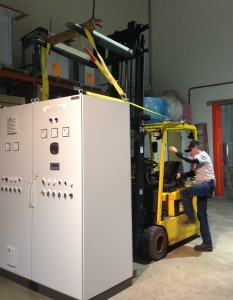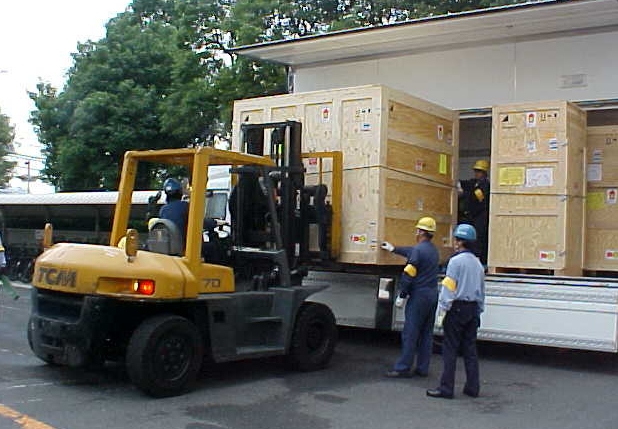When your product is ready to ship, do you imagine ordering in some custom packaging supplies and crating it on-site? You might be surprised to learn that packaging it off-site could be a better choice.
There are a very few circumstances when packaging MUST happen at your site. For example, if your product:
- Is so delicate that it cannot be safely transported to a local packaging facility without being fully crated. If your product won’t survive a short trip in an “air ride” truck on a cushioned skid, then it should be crated right where it was built.
- Must remain in a “secure location”. If you are crafting a national security prototype that must be within site of official eyes at all times, or are shipping items that are subject to nuclear industry regulations, for example, packaging will have to occur at your site.
But the majority of manufacturers will be able to choose whether or not to outsource the packaging process. Here are some key considerations:
Space
Obviously your facility is large enough to accommodate the manufacture and assembly of your product, but do you have sufficient space to crate it on-site? Maneuvering equipment onto a skid and assembling a crate around it requires some serious square footage. Depending on your particular packaging scenario, you may need room for a fork truck and/or crane, as well as all the crating and cushioning supplies.
Once the equipment is fully crated, will it be able to move easily from your facility to the truck? Double-check that the assembled crate will fit through your doors. Do you have a loading dock that a truck can pull up to? Is there a fork truck available to lift and maneuver your crate onto the truck?
If space is at a premium at your site, you could park an empty tractor trailer(s) on your property, so that equipment could be moved out of your facility as it is crated. Or you could rent a warehouse space to hold your crated items until they are all ready to be shipped out. But it might be more economical to have all of your products transported to a packaging company’s warehouse for crating and storage until your shipment date. (As a rule, industrial packaging companies tend to have much larger, open spaces ready and waiting, because that IS their normal operating condition.)

Time
Even if it’s physically possible to crate your equipment on-site, it might not make business sense to do so.
1) Will your customer be ready to receive your equipment as soon as you finish manufacturing it? Or will you need to warehouse the crate(s) somewhere for a span of time? If warehousing is necessary, it might be economical to have the crating and storage both handled at the same off-site location.
2) Will your normal operations be interrupted as you package your product? If the packaging process will monopolize manpower and/or space at your facility, it might be more cost-effective to outsource the packaging operation.
Equipment
Do you have access to the equipment needed to maneuver your product into a crate (or onto a skid, so you can assemble a crate around it)?
The size, shape, and weight of your product may mean that you need to use specialized equipment to complete the packaging process. Owning equipment that is only used occasionally can be prohibitively expensive. Rental is certainly an option, but finding qualified operators within your employee pool may prove challenging.
Alternately, you can hire a rigger to come to your site to handle the lifting and moving of large, heavy, or awkward items. They can bring their own jacks, dollies, cranes, and fork trucks. But if you’re spending money to hire in riggers and equipment, it might be more economical to simply transport your product to an industrial packaging company which will have personnel and equipment at the ready at their site.

Special Handling
If your customer plans to use your product in a cleanroom, it will need special handling as it is packaged. If it has been manufactured in a cleanroom-certified facility, you will want to make sure the packaging team follows clean room protocols. Alternately, if it has been built in a typical facility, it will need to be cleaned in a very specific way before it is packaged following clean room protocols.
In either case, outsourcing the packaging operation to a shipper with cleanroom expertise can help you to meet customer requirements. Whether the crating ultimately takes place at your facility or theirs will depend on your answers to the time, space, and equipment questions that apply to every packaging decision.
Expertise
Often the most difficult attribute to assess is whether you have the expertise in-house to handle the packaging and shipping of your equipment. Similar to home improvement enthusiasts who purchase the best materials for their project, but lack the know-how to really get their money’s worth out of their new tools, some manufacturers order the best packaging supplies, but deploy them inexpertly because packaging and shipping isn’t their primary area of expertise.
If you don’t have a shipping or rigging expert on staff, then packaging your equipment off-site might provide some savings. If the packaging experts come to your site to prep your equipment for shipment, you will be charged for their travel time, mileage for any equipment they bring with them, and, usually, a minimum number of hours of labor. If your product can be packaged more efficiently at their site, you could shave a fair amount off your shipping costs.
Your Place or Ours?
There are many variables to consider when deciding where your shipment should be packed. You may be surprised to learn that it can be cheaper to transport your equipment to a local packaging company to be prepared for shipment, rather than crating it at your site. Contact CDC today for help in determining the best location for your next pack.

